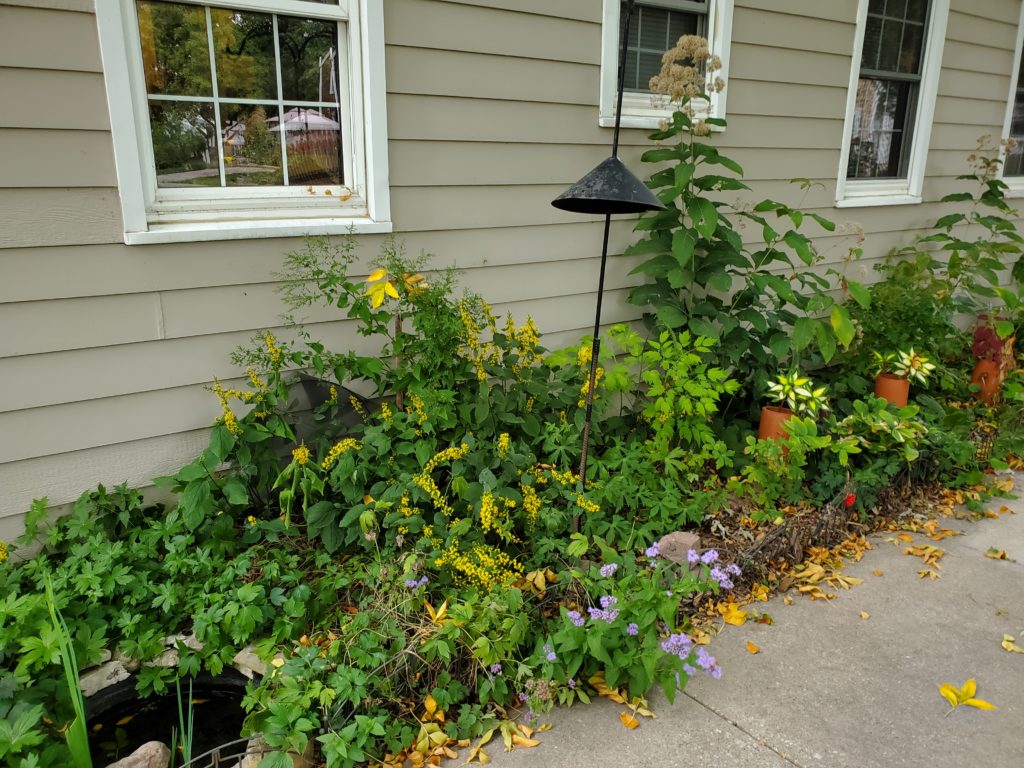
For Iowans looking to diversify their landscaping, cup-plant is one option for native wildflower landscaping. Photo by Sarah Outterson-Murphy
By Sarah Outterson-Murphy, special to the Chronicle
Fluffy seeds wave along little bluestem stalks. Tiny purple aster petals pour down shrubby branches that flop on the dry soil. End-of-summer sun beats down as bees dangle from flowers in every direction, readying food in dried flower stems and soil burrows for their winter hibernation. And under the earth, prairie roots lock carbon dioxide deep into the soil.
Gardeners and landscape managers all over Iowa have long been working to restore native prairie plants to the landscape they once covered. Eric Miller, acting co-president of the Iowa City chapter of Wild Ones, a national nonprofit organization supporting native plants, explained why he’s turning his condo lawn into patches of prairie.
“It’s more than just an aesthetic thing that you get from native plant gardening because you’re contributing to the health of the ecosystem,” said Miller. “You’re supporting the pollinators and the other insects that use the plant. And those creatures, those living things, along with the plants, are the base of the food web that everything else depends on.”
Miller explained that birdwatchers used to emphasize planting fruit trees as food for birds, but more recently, they’ve shifted focus to the whole ecosystem of native plants and insects. “If you don’t provide plants that attract insects, then you’re not going to have nesting birds,” he said.
The effort to revive ecosystems through native plants is happening more broadly in Iowa. At the Tallgrass Prairie Center at the University of Northern Iowa, Dr. Laura Jackson has spent 30 years helping county managers rethink how they plant the strips of land along highways. Jackson studies how to improve large-scale restoration of native prairies through better seed supply, planting methods, and maintenance.
Beyond supporting ecosystems and insects, two more reasons to plant prairie are to help with water quality and to slow climate change, according to Jackson. Prairie plants excel at soaking up the chemical fertilizer runoff from Iowa’s corn and soybean fields, which helps prevent that runoff from getting into public water supplies or killing fish. With their deep roots and adaptability to drought, prairie plants also are able to survive heat from a changing climate while sequestering large amounts of biomass into the soil as their roots die and regrow each year, according to research in the Soil Science Society of America Journal. Unlike trees, whose carbon is stored aboveground in wood that can easily burn back into the atmosphere, prairie plants send carbon deep into the soil where it will stay as long as the prairie grows.
Those ecological benefits are not usually the primary reason counties come to the Tallgrass Prairie Center for help with roadside prairie, Jackson acknowledged. Weed management and erosion control are more direct reasons for adding native plants, she said. But a deeper, more personal connection to prairie plants may also be part of the reason for many.
“We run into landowners who grew up in the 1960s in Iowa where there was a lot more nature around them. They could swim in the creek, they could run around in the pastures and explore and go hunting and things like that, and that Iowa is gone now. And so some of them are interested in [prairie] as a way to kind of give back to that rural community where they grew up,” said Jackson.
In Iowa City, the superintendent of Parks and Forestry, Tyler Baird, has been working since 2016 to plant more prairie plants in public gardens and landscaping, using a New Perennialism design style that emphasizes native perennial plants rather than annuals.

An example of native landscaping at the home of Eric Miller, acting co-president of Wild Ones, a not-for-profit organization that promotes environmentally sound landscaping. Photo By Eric Miller
In addition to their ecological benefits, “native plants connect people to the place and the floral history of the land,” Baird said by email.
At the Iowa City Community School District, Grounds Manager Ben Grimm has spent 10 years developing prairies on school grounds, including outdoor classrooms with monarch waystations and insect hotels. The district recently won the Green Ribbon Award through the US Department of Education for its sustainability efforts, including its prairies.
“There’s a real push for kids to get out in the sunlight to learn about their local environment and sustainability,” Grimm said.
Farther northeast, in Dubuque, Kaytlan Moeller runs a county initiative designed to help people bring that sense of nature back home. The Mowing to Monarchs program, now in its third year, supports homeowners to convert lawns of turfgrass into pollinator gardens, one 10 by 10 patch at a time.
“Typically, a front yard isn’t used for grilling or kickball,” said Moeller. “We say, why not have native plants instead of lawn?”
Turfgrass, which is native to rainy Europe, turns brown in the Iowa heat, she said. By contrast, native plants provide color and beauty, while also benefiting pollinators like monarch butterflies.
Moeller’s team, with the help of the Dubuque County Master Gardeners, provides free native plants and ongoing workshops to 60 people a year. Landowners sign on for three years of coaching, which is crucial since native plants are less familiar to many.
“Your mom can tell you how to grow a hosta; your grandma can tell you how to take care of it and split it, but most likely they can’t tell you what a rattlesnake master is or how to grow it; they can’t tell you what a butterfly weed is. That’s where we come in,” Moeller said.
Moeller says many of those who join Mowing to Monarchs have previously dabbled in landscaping ideas like No Mow May, but she believes No Mow May is not the best way to help pollinators. It’s important to distinguish between deliberately growing native plants, and just allowing weeds to take over.
“No Mow May is great for areas a little further north, where plants stay dormant longer, but here in Iowa it encourages more weedy things, things that don’t help pollinators,” she said.
Those weeds can be a big concern for would-be native plant gardeners because often neighbors can have opinions about the changing landscape. At the Iowa City Community School District, for example, neighbors sometimes found schools’ prairie plantings an unwelcome change, whether because of fears about bees and rodents, or because of the wilder look.
“There isn’t a fence, necessarily, dividing neighbors’ property versus our property. So technically, it appears as if their lawns are bigger and kind of extended into the district property. Well, the second you put up prairie, it kind of changes that aesthetic,” said the grounds manager, Ben Grimm.
Similarly, a 2020 Iowa City Parks plan to plant 86 acres of prairie was reduced to 57 acres after pushback from neighbors concerned about the lack of recreational space.
“There will always be some level of resistance to any planting style that is implemented. We live in a diverse community with many ideas and experiences that shape the way plants are viewed. We receive occasional complaints about our more natural planting efforts and our prairie areas spread around town. However, we have received many more compliments and praise for our efforts than complaints,” said Baird by email.
One last challenge to maintaining prairies can be funding. There is a misconception that prairies are a cheap option compared to lawns, said Grimm. But native plant seeds are not cheap, and prairies still need maintenance.
“A lot of people say, ‘Oh, it’s a cost-saving measure,’” said Grimm. “And it does save money, but it’s not significant.”
Funding cuts are directly affecting a major prairie in Iowa, the Neal Smith National Wildlife Refuge in Prairie City. There, 6,000 acres of windswept prairie, crossed with gravel roads, sustain a herd of several dozen bison and elk. A visitor’s center welcomes children with exploratory exhibits celebrating prairie plants and animals. Scott Gilje, refuge manager, described the refuge’s “hands-off approach” to managing the bison, with the goal of keeping them as wild as possible while still accessible to the public.
“I want people to come out and enjoy their national wildlife refuge,” Gilje said.
But funding cuts have made it harder to preserve and maintain the bison and their habitat. In the last seven years, the Neal Smith refuge staff has gone from 12 full-time employees to three, due to cuts, Gilje said.
When asked about the funding cuts to the Neal Smith National Wildlife Refuge, Senator Joni Ernst’s office replied in a voicemail, “The omnibus bill that funded the government for fiscal year 2023 did appropriate the US Fish and Wildlife Service a little over $1.5 billion.”
Back in Iowa City, Eric Miller is doing his part for the prairies by working to expand his local chapter of Wild Ones, starting new prairie plants to give away, and adding new natives to his gardens.
“A really lovely one that hugs the ground is Missouri Evening Primrose,” Miller said. “It has really interesting foliage, and just really lovely big yellow flowers, kind of a pale yellow flower. Its coloration attracts moths, the main pollinator of the plant. And it has that coloration because that makes the flowers visible at night when most of the moths are out.”
Does he like those flowers because they sustain moths, or because they’re simply beautiful?
Why not both?





Comments